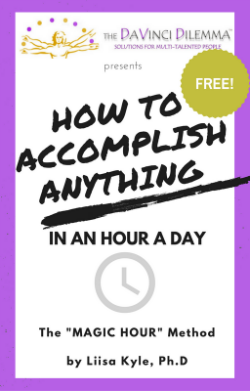
CCO creative commons image via pexels.com
Are you stuck? Is motivating yourself a challenge? Are you procrastinating or wasting time or otherwise NOT doing what you intend? Maybe you are chipping away at some task…but doing so unproductively or less effectively than you’d like. If you haven’t done so recently, you may wish to revisit the notion of “quotas” — of assigning yourself a minimum amount of tasks to be completed within a given amount of time.
For example, many writers commit to a daily minimum of words or page written. Business people may aim for a certain number of cold calls or new clients per week or per month. Dancers, musicians, and athletes may set goals for certain amounts of specified training or practice on each day of each week.
One reason quotas can be especially effective for DaVincis – smart, creative people juggling several talents, projects and ideas — is that quotas provide a very light structure to support and enhance creativity. It’s simple guiding notion — rather than a complex, oppressive, 9-to-5 prison.
Quotas can motivate you do get things done — while still providing you with flexibility in how or when you do so. For example, if I commit to write (at least) four articles a week, I can do them whenever I want, fitting them in among whatever else my week holds. It doesn’t matter what arises in work or any other life domain . . . as long as a minimum of four pieces are filed by end of day Friday.
Besides flexibility, another upside is that quotas tend to specific a ‘minimum’. Once you accomplish your intended goal, it’s intrinsically gratifying. As a bonus, if you choose to, you can do more, which can feel even better. In fact, my coaching clients often find it more motivating to assign a conservative quota that it is relatively easy…and oh so pleasant…to achieve, in part because it often stimulates them to do more — to exceed their minimum target.
Quotas have other benefits as well.
They can ensure you are actually participating in the things you wish to do. Just as they work for professional activities, they also can work for other areas of life. If you are looking to improve your nutrition, you could make a point of eating a salad every day. If you love to read, why not aim to read a book a week or a month (or whatever rate make sense your life situation)? If you love being outdoors but notice it’s been weeks since you did so, establishing a minimum ‘time outside’ target can ensure you don’t let this simple pleasure slip get forgotten amid everything else you’re doing.
It’s up to you to decide what’s important.
***
Activity: What would you like to be doing more of? What are you not doing enough of? Make a list. Now, for each item on your list, ask yourself: what would be an appropriate target quota to aim for, given your life circumstances these days?
***
Also consider that quotas can motivate you to tackle activities that are less enjoyable but necessary. For example, if you don’t like housework, you could set a minimum amount of time per day or per week to your chores. It’s surprising what you can get done in even fifteen minutes a day. Alternatively, you could create a realistic list of minimum ‘to do’ tasks for the week.
When tackling things you don’t enjoy doing, it’s important to choose the smallest, easiest, more conservative quota possible. If your target is too ambitious, you won’t do it and you’ll feel worse about it. If in doubt, aim for less.
***
Activity: What necessary activities do you find it difficult to make yourself do? Make a list. Now, for each item on your list, ask yourself: what would be the smallest, easiest, most conservative target quota you could aim for, given your life?
***
Along the same lines, quotas are great for starting new healthy habits.
For best results, being with laughably small targets. For example, let’s say you don’t like to exercise but would like to start. Rather than beginning by committing to run for thirty minutes every day, why not start with something you KNOW you can do — and that you know you WILL do — such a walking at least six minutes a day. Start with that. When you do this reliably for, say, a week, you might replace one minute of your walking with one minute of running. Gradually, as you experience success meeting a particular quota, you could increase the challenge a titch. If you did so, it wouldn’t take that long before you were, actually, running for thirty minutes a day, three times a week.
***
Activity: What healthy habits would you like to start? Make a list. Pick whichever of these is most important or most interesting for you right now. Now, ask yourself: what would be a laughably easy way to begin?
***
Quotas can also curtail unhelpful or unhealthy behaviors.
If you are an internet junkie, for example, you can use quotas to help you shift your habit. You could limit your internet surfing to, say, 30 minutes per day. This gives you permission to indulge but prevents you from over-indulging.
***
Activity: What unhealthy or unhelpful habits do you have? What would you like to be doing less of? Make a list. Pick whichever of these is most important or most detrimental for you right now. Now, ask yourself: what would be reasonable new limit on this activity? What target quotas can you commit to?
***
Quotas can be reinforced and enhanced with rewards.
While meeting quotas in intrinsically gratifying, you can solidify your preferred behavioral patterns by rewarding yourself whenever you meet your quotas. This is especially true if you are using quotas to curtail an unwanted behavior: I strongly suggest you reward yourself for each and every successful accomplishment along the way.
The challenge with rewards, however, is that many of us have a hard time actually treating ourselves. It’s up to you to identify what are fitting, pleasant, reasonable, do-able rewards for meeting your target. It doesn’t work if you promise yourself a massage a week for exercising if you don’t then actually enjoy a massage for each week you exercise.
It’s up to you to actually treat yourself. It’s up to you to set up your rewards so they really happen when you meet your goals.
***
Activity: What is a quota you’d like to establish? What would be a pleasant and fitting and do-able reward you would enjoy for meeting your goals? How can you put this in place so it actually happens?
***
Will quotas work for you?
It depends on the nature of your creative work, your personality, your situation, and your personal preference.
Reflect for a moment: Have quotas worked well for you in the past? Are you using them currently? If not, might it be an opportunity to reinstate them? Do they need any tweaking?
If quotas have not worked well for you in the past, ask yourself why not? Were you overly ambitious in your targets or time frames? Were your targets too complex or numerous for your schedule? If so, would a more conservative approach work better for you?
If you haven’t yet tried using quotas as a motivational technique, give them a try. See to what extent they can help you get more done with less procrastination and stress along the way.
***
For for tips and techniques to be more productive, check out my book YOU CAN GET IT DONE
***
Want to re-publish this article? Go for it – just include the author’s name, a link to this original post and the following text blurb:
Are you struggling with too many talents, skills, ideas? You may have The DaVinci Dilemma™! Find tools, fun quizzes, coaching, inspiration and solutions for multi-talented people at http://www.davincidilemma.com/ .




